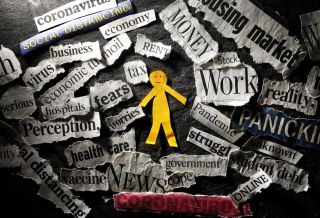
Source: kali9/iStock
As I write this, a mass shooting with multiple fatalities on the UNLV campus is the lead story on all of the major news stations across America. According to the Gun Violence Archive, this event marks 631 mass shootings in the U.S. this year. It’s a phenomenon uniquely American, and one that will likely have long-term consequences for the next generation of Americans whose childhood memories will forever include repetitive active shooter drills and the practice of lockdown procedures for when a gun-wielding assassin enters their school. Furthermore, these effects are not isolated to children; they extend to parents, teachers, and school administrators (El Sherief, et al., 2021).
The gun violence epidemic is just one of many stressors that Americans have faced this year. According to the American Psychological Association’s (APA) annual survey, Stress in America 2023: A Nation Recovering from Collective Trauma, 2023 has been a year of “era-defining crises” that has resulted in wide-spread collective trauma and lasting mental and physical distress.
While the nation may have sighed a collective breath of relief after President Biden signed H.J. Res 7 in April of 2023, officially ending the national public health emergency of COVID-19 and symbolically returning some sense of normalcy to our lives, the APA survey revealed that there was nothing normal about 2023 as it relates to stress. In addition to the wide-ranging aftereffects of COVID-19 on our psyche, Americans also reported significant stress related to global conflict, racial injustice, racism, inflation, and climate change. In fact, Stress in America 2023 survey results were so dramatic that APA psychologists opined that a substantial percentage of America is currently suffering from “the psychological impacts of a collective trauma.”
As explained by APA’s CEO, Dr. Arthur Evans Jr., the aftereffects of the COVID-19 pandemic have been wide-ranging and longstanding due to the dramatic disruptions not only to our health but in how we worked, how we played, how our children received their educations, how we experienced important developmental milestones, and how we interacted with friends and family (Washington Journal C-SPAN, 2023). It impacted practically every aspect of how we lived our lives. It did this for years, and clearly it continues to affect a significant number of Americans.
Highlights of APA’s Survey Results (for full results, see Stress in America 2023: A nation recovering from collective trauma (apa.org))
The APA data revealed that that long-term stress associated with the pandemic has had significant effects on American’s physical and mental well-being, as evidenced by an increase in chronic illnesses and an increase in mental health diagnoses. These effects were particularly pronounced for Americans between 35 and 44 years of age, yet effects were seen across all age ranges (18 and above).

Source: zimmytws/iStock
Not surprising given the wide divisions in America’s views on policy and politics, other significant sources of reported stress were the media and politics. For example, 50 percent of those surveyed indicated that one source of stress is that the news isn’t focused on the day-to-day issues that are most important to them; even more (59 percent) said the same about politicians. In addition, only 34 percent of respondents expressed confidence in the direction they perceive America is headed, and only 31 percent felt that government officials are representing their best interests.
Other prominent stressors include:
- our nation’s future (68%)
- health-related issues (65%)
- the economy (64%)
- money (63%)
- violence and crime (61%)
- U.S. debt (57%)
- mass shootings (56%)
- social divisiveness (55%), and
- health care (54%).
Lastly, the survey reported that “discrimination is not only a stressor in some adults’ minds, but perhaps a very real presence in their everyday life and potentially a harm to their personal safety,” with 39 percent of respondents reporting that personal safety is a significant source of stress in their lives. Subgroups that reported feeling the stress of discrimination more directly and prominently include LGBTQIA+ individuals, people with disabilities, Blacks, and Latinos/as/es.
With this amount of stress, it’s important that Americans have and utilize effective stress management strategies—or at least feel they can share their stress with others. However, this does not appear to be the case. The survey revealed that approximately three in five adults reported that they don’t discuss their stress because they don’t want to burden others with it, and the same number revealed that they think that those around them simply expect them to “get over” it. That said, a significant number of respondents wished they had more support: 66 percent reported that they could have used more emotional support than they received this past year; 55 percent wished they had someone to consult for advice and/or support; 44 percent indicated that no one seemed to understand what they were going through; and 47 percent wished they had someone to help them manage their stress. At the same time, many respondents didn’t appear to know how to get the relief they felt they needed (36 percent reported not knowing how to manage their stress, and 33 percent reported feeling “completely stressed out no matter what they do to manage their stress”).
These results do not bode well for Americans’ stress levels in the future. In one of the wealthiest countries in the world, we should be doing a much better job of educating people about stress management, especially forms of stress management that are cost-free since several of the reported stressors were directly related to finances. For example, I recommend nature-based stress relievers that have been shown to have significant therapeutic benefits without a major time commitment. These include listening to relaxing sights and sounds, such as songbirds, and taking nature walks, which have the extra benefit of exposure to other natural stress relievers such as fresh air, sunlight, and green spaces (Bourg Carter, 2023). Research suggests that even short exposure to these kinds of natural stress relievers produces stress-relieving benefits (Hunter, Gillespie, & Chen, 2019; Ferraro, et al, 2020). Meditation, deep breathing, and mindfulness exercises also are free and easy. For those who have more resources, there are many other forms of stress relief available, including yoga classes, massage, team sports, and spa days. Therapy also is an option for those who can afford professional care.
Whichever form of stress management is used, Dr. Evans emphasizes the importance for each individual to identify not only what controllable factors stress them out, but also to “be intentional” in their selection of stress management efforts. He explains that intentionality has to do with each person’s awareness of where their stress level is on any given day and their use of that information to be purposeful in deciding which activities or experiences are likely to make them feel worse or better. As a personal example, he offered that when he is feeling particularly tired or stressed, he intentionally avoids watching the news since doing so often makes him feel worse. Instead, he finds an activity that he knows from experience will counter his stress.




















+ There are no comments
Add yours